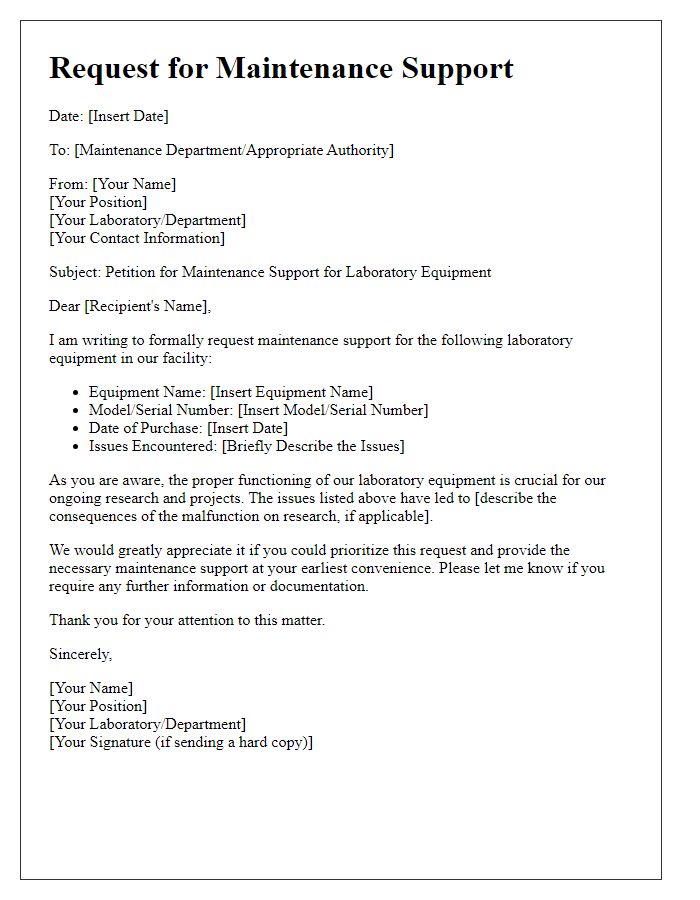Are you looking to streamline your laboratory operations but don't know where to start? Writing an effective request for laboratory equipment is crucial to ensure you get the tools you need for your research or experiments. In this article, we will guide you through the essential components of a well-crafted letter that speaks to your needs while maintaining professionalism. Stay tuned as we dive into tips and templates that make your request stand out!

Purpose and justification
Laboratory equipment requests often stem from the need to enhance research capabilities or improve experimentation accuracy. Essential instruments, such as spectrophotometers, analytical balances, or incubators, play critical roles in various scientific disciplines, including biochemistry or environmental science. Justification for acquiring such equipment may relate to increased experimental demands, project timelines, or staff safety considerations. For instance, a specific project may require precise measurements of chemical absorbance, necessitating a high-performance spectrophotometer. Additionally, outdated or malfunctioning equipment can result in compromised data quality, hindering research progress. Therefore, ensuring access to reliable and modern laboratory equipment not only fosters scientific innovation but also aligns with institutional goals for research excellence.
Equipment specifications
Laboratories often require specialized equipment for precise experiments, such as spectrophotometers, which measure light absorbance at specific wavelengths. Detailed specifications, including wavelength range (typically from 200 nanometers to 800 nanometers) and resolution (usually 1 nanometer), are crucial for ensuring accuracy. Additionally, centrifuges are vital for separating components based on density, with a maximum speed measured in RPM (revolutions per minute), often needing to exceed 15,000 RPM for specific applications. Essential features like temperature control (certain protocols may require ranges from 0 to 40 degrees Celsius) and rotor type compatibility can significantly impact experimental outcomes. Understanding these specifications facilitates better resource allocation and optimizes laboratory workflows.
Budget and funding sources
Laboratory equipment requests for funding typically include a detailed budget breakdown. Essential components of the budget include itemized costs for each piece of equipment, such as spectrophotometers ($2,500 each), centrifuges ($1,800 each), and microscopes ($3,200 each). Additional expenditures may encompass maintenance contracts, which can vary from $300 to $800 annually, and potential shipping fees that typically range from $200 to $500. Funding sources may include institutional grants, government research funds like the National Science Foundation (NSF), and private sector sponsorships, which could provide financial support through partnerships. Justification for equipment necessity should align with proposed research objectives, highlighting expected outcomes that could impact fields such as biotechnology or environmental science. A well-structured proposal should demonstrate both the cost-effectiveness and the potential return on investment for the benefactors.
Impact on research or operations
Inadequate laboratory equipment can significantly hinder research productivity and operational efficiency, especially in high-stakes environments such as biomedical research facilities or environmental testing labs. Essential tools like centrifuges and spectrophotometers play vital roles in sample analysis and data acquisition, directly influencing the accuracy of experiments. For instance, a malfunctioning incubator can lead to uncontrollable temperature fluctuations, affecting cell cultures and potentially resulting in erroneous data and delayed research outcomes. Furthermore, outdated equipment can increase downtime, as frequent repairs become necessary, leading to interruptions in experimental workflows. Access to state-of-the-art instruments enables researchers to conduct advanced analyses, fosters innovation, and enhances the overall quality of scientific investigations, emphasizing the importance of timely equipment updates and replacements.
Approval procedures and required documentation
Laboratory equipment requests necessitate adherence to specific approval procedures to ensure efficient procurement. Documentations including a detailed justification report outlining the necessity for the equipment, estimated costs, and potential impacts on research outcomes must be prepared. Additionally, obtaining endorsements from department heads or principal investigators is crucial for securing approval. Submission of a formal requisition form tailored to institutional guidelines is also required, alongside relevant quotes from vendors such as Fisher Scientific or VWR. Timelines should be considered due to possible delays in availability or budgetary reviews within designated financial cycles, often occurring quarterly or yearly.
Letter Template For Laboratory Equipment Request Samples
Letter template of laboratory equipment requisition for research purposes

Letter template of laboratory equipment solicitation for grant-funded projects

Letter template of laboratory equipment appeal for teaching laboratories

Letter template of laboratory equipment petition for maintenance support










Comments